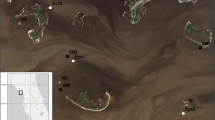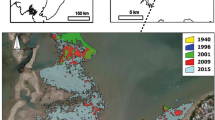Abstract
The tropically associated black mangrove (Avicennia germinans) is expanding into salt marshes of the northern Gulf of Mexico (nGOM). This species has colonized temperate systems dominated by smooth cordgrass (Spartina alterniflora) in Texas, Louisiana, Florida and, most recently, Mississippi. To date, little is known about the habitat value of black mangroves for juvenile fish and invertebrates. Here we compare benthic epifauna, infauna, and nekton use of Spartina-dominated, Avicennia-dominated, and mixed Spartina and black mangrove habitats in two areas with varying densities and ages of black mangroves. Faunal samples and sediment cores were collected monthly from April to October in 2012 and 2013 from Horn Island, MS, and twice yearly in the Chandeleur Islands, LA. Multivariate analysis suggested benthic epifauna communities differed significantly between study location and among habitat types, with a significant interaction between the two fixed factors. Differences in mangrove and marsh community composition were greater at the Chandeleurs than at Horn Island, perhaps because of the distinct mangrove/marsh ecotone and the high density and age of mangroves there. Infaunal abundances were significantly higher at Horn Island, with tanaids acting as the main driver of differences between study locations. We predict that if black mangroves continue to increase in abundance in the northern GOM, estuarine faunal community composition could shift substantially because black mangroves typically colonize shorelines at higher elevations than smooth cordgrass, resulting in habitats of differing complexity and flooding duration.










Similar content being viewed by others
References
Anderson, Marti J., Ray N. Gorley, and K. Robert Clarke. 2008. PERMANOVA+ for PRIMER: guide to software and statistical methods. Plymouth: PRIMER-E.
Baker, Ronald, Marcus Sheaves, and Ross Johnston. 2015. Geographic variation in mangrove flooding and accessibility for fishes and nektonic crustaceans. Hydrobiologia 762 (1): 1–14. https://doi.org/10.1007/s10750-015-2329-7.
Beck, Michael W., Kenneth L. Heck Jr., Kenneth W. Able, Daniel L. Childers, David B. Eggleston, Bronwyn M. Gillanders, Benjamin Halpern, Cynthia G. Hays, Kaho Hoshino, Thomas J. Minello, Robert J. Orth, Peter F. Sheridan, and Michael P. Weinstein. 2001. The identification, conservation, and management of estuarine and marine nurseries for fish and invertebrates. Bioscience 51 (8): 633–641.
Bianchi, Thomas S., Mead A. Allison, Jun Zhao, Xinxin Li, Rebecca S. Comeaux, Rusty A. Feagin, and R.Wasantha Kulawardhana. 2013. Historical reconstruction of mangrove expansion in the Gulf of Mexico: linking climate change with carbon sequestration in coastal wetlands. Estuarine, Coastal, and Shelf Science 119: 7–16.
Boesch, Donald F., and R. Eugene Turner. 1984. Dependence of fishery species on salt marshes: the role of food and refuge. Estuaries and Coasts 7 (4): 460–468.
Caudill, Melanie C. 2005. Nekton utilization of black mangrove (Avicennia germinans) and smooth cordgrass (Spartina alterniflora) sites in southwestern Caminada Bay, Louisiana (Master’s Thesis, Faculty of the Louisiana State University and Agricultural and Mechanical College in partial fulfillment of the requirements for the degree of Master of Science in The Department of Oceanography and Coastal Sciences by Melanie Christine Caudill BS, University of Florida). http://etd.lsu.edu/docs/available/etd-11142005-101616/
Cavanaugh, Kyle C., James R. Kellner, Alexander J. Forde, Daniel S. Gruner, John D. Parker, Wilfred Rodriguez, and Ilka C. Feller. 2014. Poleward expansion of mangroves is a threshold response to decreased frequency of extreme cold events. Proceedings of the National Academy of Sciences 111 (2): 723–727.
Coblentz, Kyle E., Jessica R. Henkel, Bryan J. Sigel, and Caz M. Taylor. 2015. Influence of sediment characteristics on the composition of soft-sediment intertidal communities in the northern Gulf of Mexico. PeerJ 3: e1014.
Comeaux, Rebecca S., Mead A. Allison, and Thomas S. Bianchi. 2012. Mangrove expansion in the Gulf of Mexico with climate change: implications for wetland health and resistance to rising sea levels. Estuarine, Coastal and Shelf Science 96: 81–95.
Cook-Patton, Susan C., Michael Lehmann, and John D. Parker. 2015. Convergence of three mangrove species towards freeze-tolerant phenotypes at an expanding range edge. Functional Ecology 29 (10): 1332–1340.
Fodrie, F. Joel, Kenneth L. Heck Jr., Sean P. Powers, William M. Graham, and Kelly L. Robinson. 2010. Climate-related, decadal-scale assemblage changes of seagrass-associated fishes in the northern Gulf of Mexico. Global Change Biology 16 (1): 48–59.
Hettler, William F., Jr. 1989. Nekton use of regularly-flooded saltmarsh cordgrass habitat in North Carolina, USA. Marine Ecology Progress Series. Oldendorf 56 (1): 111–118.
Johnson, Matthew W., and Kenneth L. Heck Jr. 2006. Effects of habitat fragmentation per se on decapods and fishes inhabiting seagrass meadows in the northern Gulf of Mexico. Marine Ecology Progress Series 306: 233–246.
Johnston, Cora A., and Olivia N. Caretti. 2017. Mangrove expansion into temperate marshes alters habitat quality for recruiting Callinectes spp. Marine Ecology Progress Series 573: 1–14.
Kangas, Partrick C., and Ariel E. Lugo. 1990. The distribution of mangroves and salt marsh in Florida. Tropical Ecology 31 (1): 32–39.
Karban, Richard, and SharonY. Strauss. 2004. Physiological tolerance, climate change, and a northward range shift in the spittlebug, Philaenus spumarius. Ecological Entomology 29 (2): 251–254.
Kneib, Ronald T. 1992. Population dynamics of the tanaid Hargeria rapax (Crustacea: Peracarida) in a tidal marsh. Marine Biology 113 (3): 437–445.
Krauss, Ken W., Karen L. McKee, and Mark W. Hester. 2012. Water use characteristics of black mangrove (Avicennia germinans) communities along an ecotone with marsh at a northern geographical limit. Ecohydrology 7 (2): 354–365.
Krebs, Charles J. 1989. Species diversity measures. In Ecological Methodology, ed. Harper & Row, 328–368. New York.
Lunt, Jessica, Kimberly McGlaun, and Elizabeth M. Robinson. 2013. Effects of black mangrove (Avicennia germinans) expansion on saltmarsh (Spartina alterniflora) benthic communities of the South Texas coast. Gulf and Caribbean Research 25 (1): 125–129.
McKee, Karen L., and Jill E. Rooth. 2008. Where temperate meets tropical: multi-factorial effects of elevated CO2, nitrogen enrichment, and competition on a mangrove-salt marsh community. Global Change Biology 14 (5): 971–984.
Morgan, James A., and Robert C. Treadwell. 1954. Cemented sandstone slabs of the Chandeleur Islands, Louisiana. Journal of Sedimentary Petrology 24 (2): 71–75.
Orth, Robert J., and Jacques Van Montfrans. 1987. Utilization of a seagrass meadow and tidal marsh creek by blue crabs Callinectes sapidus. 1. Seasonal and annual variations in abundance with emphasis on post-settlement juveniles. Marine Ecology Progress Series 41 (3): 283–294.
Osland, Michael J., Nicholas Enwright, Richard H. Day, and Thomas W. Doyle. 2013. Winter climate change and coastal wetland foundation species: salt marshes vs. mangrove forests in the southeastern United States. Global Change Biology 19 (5): 1482–1494.
Perry, Carey L., and Irving A. Mendelssohn. 2009. Ecosystem effects of expanding populations of Avicennia germinans in a Louisiana salt marsh. Wetlands 29 (1): 396–406.
Peterson, Jennifer M., and Susan S. Bell. 2015. Saltmarsh boundary modulates dispersal of mangrove propagules: implications for mangrove mitigation with sea-level rise. PLoS One 10 (3): e0119128. https://doi.org/10.1371/journal.pone.0119128.
Pickens, Christine N., and Mark W. Hester. 2010. Temperature tolerance of early life history stages of black mangrove Avicennia germinans: implications for range expansion. Estuaries and Coasts 34 (4): 824–830.
Pickett, Steward T. 1989. Space-for-time substitution as an alternative to long-term studies. In Long-term studies in ecology, 110–135. New York: Springer.
Raabe, Ellen A., Laura C. Roy, and Carole C. McIvor. 2012. Tampa Bay coastal wetlands: nineteenth to twentieth century tidal marsh-to-mangrove conversion. Estuaries and Coasts 35 (5): 1145–1162.
Rakocinski, Chet, Richard W. Heard, Ted Simons, and Diane Gledhill. 1991. Macroinvertebrate associations from beaches of selected barrier islands in the northern Gulf of Mexico: important environmental relationships. Bulletin of Marine Science 48 (3): 689–701.
Roberston, Alistar I., and Norman C. Duke. 1987. Mangroves as nursery sites: comparisons of the abundance and species composition of fish and crustaceans in mangroves and other nearshore habitats in tropical Australia. Marine Biology 96 (2): 193–205.
Robertson, Alistar I. 1979. The relationship between annual production: biomass ratios and lifespans for marine macrobenthos. Oecologia 38 (2): 193–202.
Rozas, Lawrence P., and Thomas J. Minello. 1998. Nekton use of salt marsh, seagrass, and non-vegetated habitats in a south Texas (USA) estuary. Bulletin of Marine Science 63 (3): 481–501.
Scheffel, Whitney A., Kenneth L. Heck Jr., Just Cebrian, Matthew W. Johnson, and Dorothy Byron. 2013. Range expansion of black mangroves (Avicennia germinans) to the Mississippi barrier islands. Gulf of Mexico Science 31 (2): 79–82.
Sheridan, Peter, and Cynthia Hays. 2003. Are mangroves nursery habitat for transient fishes and decapods? Wetlands 23 (2): 449–458.
Sherrod, C. Lee, and Calvin McMillan. 1985. The distributional history and ecology of mangrove vegetation along the northern Gulf of Mexico coastal region. Contributions in Marine Science 28: 129–140.
Stevens, Philip W., Sandra L. Fox, and Clay L. Montague. 2006. The interplay between mangroves and salt marshes at the transition between temperate and subtropical climate in Florida. Wetlands Ecology and Management 14: 435–444.
Thayer, Gordon W., David R. Colby, and William F. Hettler Jr. 1987. Utilization of the red mangrove prop root habitat by fishes in south Florida. Marine Ecology Progress Series 35: 25–38.
Valentine, John F., and Kenneth L. Heck Jr. 1993. Mussels in seagrass meadows: their influence on macroinvertebrate abundance and secondary production in the northern Gulf of Mexico. Marine Ecology Progress Series 96: 63–74.
Whaley, Shannon D., and Thomas J. Minello. 2002. The distribution of benthic infauna of a Texas salt marsh in relation to the marsh edge. Wetlands 22 (4): 753–766.
Acknowledgements
We thank the United States Fish and Wildlife Service for funding the majority of the field portion of this project, especially Patric Harper, who provided field help and financial support throughout this study (contract no. F11AC01390). Thanks to the Science and Resource Management Division at the National Park Service’s Gulf Islands National Seashore for providing assistance and additional resources for completing fieldwork. We would like to acknowledge Dorothy Byron, Kristen Dahl, and Josh Goff for their help and expertise in creating GIS field maps.
Author information
Authors and Affiliations
Corresponding author
Additional information
Communicated by Mark J. Brush
Electronic supplementary material
ESM 1
(DOCX 69 kb)
Rights and permissions
About this article
Cite this article
Scheffel, W.A., Heck, K.L. & Johnson, M.W. Tropicalization of the Northern Gulf of Mexico: Impacts of Salt Marsh Transition to Black Mangrove Dominance on Faunal Communities. Estuaries and Coasts 41, 1193–1205 (2018). https://doi.org/10.1007/s12237-017-0334-y
Received:
Revised:
Accepted:
Published:
Issue Date:
DOI: https://doi.org/10.1007/s12237-017-0334-y




